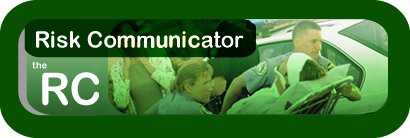The Risk Communicator Newsletter

Providing information and resources to help emergency risk communicators prepare and effectively respond in the event of a crisis.
Research Summaries: Summaries of Work from Deborah Glik and Craig Lefebvre
Deborah Glik's "Risk Communication for Public Health Emergencies"
In her recent article in the Annual Review of Public Health, Deborah Glik conducts an overview of different research areas and practical applications that have shaped current risk communication theory and practice in the field of public health. Defining the concept of emergency risk communication as "accurate and effective communication to diverse audiences in emergency situations," Glik provides background information on how this particular field came into existence.
According to Glik, the field of emergency risk communication has roots in four specific areas of communication: environmental risk communication, disaster management, health promotion and communication, and media and communication studies. Glik contends that risk communication in the field of public health is relatively similar to risk communication practices in other fields, differing mainly in message content.
The author is encouraged not only by the increasing number of emergency risk communication publications and exercises, but also by the increased visibility of public health agents and the emergency messages they deliver (e.g., during the West Nile and SARS outbreaks, avian flu pandemic preparations, etc.). She stresses that significant progress has been made to include emergency risk communication principles in public health practice. Glik notes that even though public health professionals are improving upon their risk communication skills and experience, the field requires more in-depth evaluation to assess true effectiveness.
Glik, DC. Risk communication for public health emergencies. Ann Rev Public Health 2007;28:33-54.
Craig Lefebvre's "New Technology: The Consumer as a Participant Rather Than Target Audience"
In a recent article published in Social Marketing Quarterly, Craig Lefebvre introduces and defines new communication technologies and the emergence of what is being called "Web 2.0." Lefebvre explains how new technologies, and social media in particular, can be applied in health promotion programs. Lefebvre's analysis has implications across a wide range of health initiatives including emergency risk communication. He also explains the implications of these new technologies for the behaviors we promote; the products and services we market; the incentives and costs to be considered; and the places where we interact with our audiences.
The author argues that many communication practitioners initially approach new technologies without recognizing their radical differences from traditional channels that do the same old things. Lefebvre suggests that these new technologies reveal a networked world, one in which the practitioner creates "messages" that reach audiences, but audience members also talk to the practitioner; and, just as importantly, with each other.
Lefebvre contends that new media requires a shift in thinking about how we communicate with our audiences. Though audience-generated content (AGC)-content generated independently by individuals, not through organizations-is not a novel idea, new technologies make it more accessible and broadly disseminated. Our greatest challenge as communication practitioners is the radical change in perspective, acknowledging that audiences are increasingly in charge of what they look at and listen to.
Lefebvre recommends how practitioners should respond to this new world and engage in it through collaboration, sharing, and interactivity. He proposes that practitioners consider the following five 'Es':
The five 'Es' are as follows:
- Education: Are we educating people about issues and problems that are relevant to them?
- Engagement: Are we engaging people in positive and meaningful ways?
- Entertainment: Is there an entertainment value to our offerings?
- Empowerment: Do people believe and feel empowered as a result of their experiences with our programs (products and services)?
- Evangelism: Do we take advantage of every opportunity to let our customers and clients become evangelists? For us? Our programs?
Lefebvre, RC. New technology: The consumer as a participant rather than target audience. Soc Mar Q 2007;13(3):31-42.
- Page last updated May 22, 2010
- Page last reviewed May 22, 2010
- Content source: Office of Public Health Preparedness & Response (OPHPR) > Division of Emergency Operations (DEO) > Emergency Risk Communication Branch (ERCB)xxxx
Get email updates
To receive email updates about this page, enter your email address:
Contact Us:
- Centers for Disease Control and Prevention
1600 Clifton Rd
Atlanta, GA 30333 - 800-CDC-INFO
(800-232-4636)
TTY: (888) 232-6348 - Contact CDC-INFO



